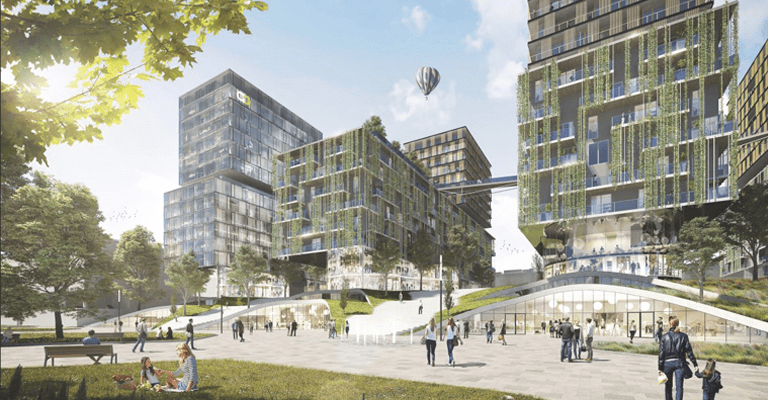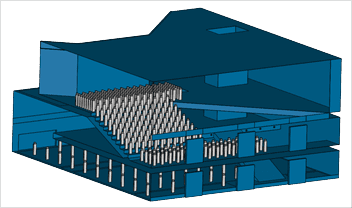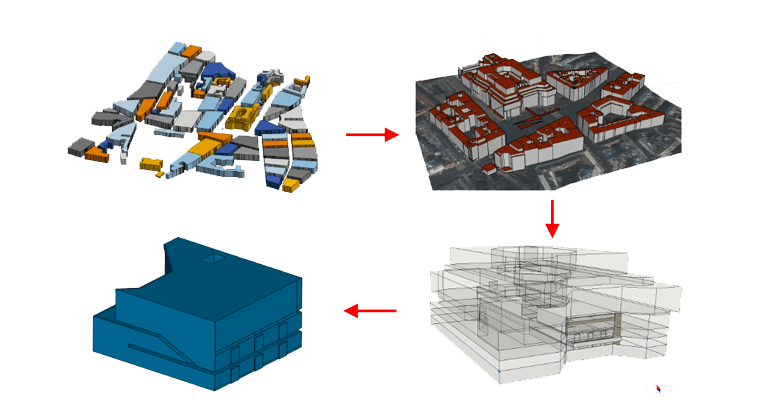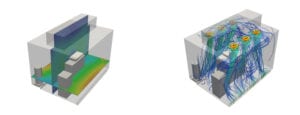
Ingenieurbüro Gratzl specializes in simulation methods for building physics. Under the name Green.Building.Simulation, complex simulation calculations for buildings, systems, air flows, daylight, components, and other special questions from thermal and hygric building physics are carried out. The main focus of Markus Gratzl’s work is to help building planners (architects, HVAC engineers) improve their buildings and systems in terms of energy efficiency and thermal comfort.
Markus Gratzl’s project consisted of evaluating the thermal comfort of an immense entrance hall of a former university building. This project, as part of a larger developmental project called the Althan Quarter on Alsergrund in Vienna, aims to bring a sustainable mix of accommodation, offices, hotels, local suppliers, and additional infrastructures to the area, and is expected to be completed in 2023.

Markus’ simulation dealt with the four-storey entrance hall of the building, including the entrance to the railway station’s platforms. The goal of the analysis was to clarify whether or not the entrance hall could be thermally conditioned by passive ventilation measures during hot summer periods. If not, they would need to develop measures to improve thermal comfort during hot periods with as little energy usage as possible.
Markus turned to computational fluid dynamics (CFD) using SimScale to fulfill the needs of the project. Through CFD simulation, he was able to address two main goals:


With the completion of these goals leading the way for the project’s success, it was determined that such investigations could only be performed with flow simulation software. When Markus discovered SimScale’s cloud-based CFD software, it was a perfect fit for his small and specialized business. With the need for expensive hardware and high investment costs eliminated, Ingenieurbüro Gratzl got to work using SimScale.
SimScale gives me, for the first time as a small specialized engineering office, the possibility to use CFD simulations for building optimization. Other software packages cause much too high investment costs for hardware and software.

Markus Gratzl
Expert in the field of Green Building Simulation and owner of Ingenieurbüro Gratzl, professor for Simulation Methods in Building Physics at Salzburg University of Applied Sciences.
Ingenieurbüro Gratzl ran the two flow simulations crucial to the project: internal and external airflow simulations. The setup for each consisted of the following:
Markus used a step-by-step approach to investigate the airflow and achieve their specified goals. The steps can be visualized below:

The external flow simulation took around 30 minutes, and used an automatic number of cores (14 core hours). The internal flow simulation was longer with a three-hour runtime, using 300 core hours on 96 cores.
Due to the requirements of the project, it took some time to calibrate the correct settings for both the external and internal flow simulations. Additionally, integrating radiation and thermal comfort for the internal flow simulation needed some prep time. After a few test runs and help from the SimScale support team, Markus was able to get the desired results.
The internal flow simulation found that a pronounced temperature stratification developed in the entrance hall, which is around 16 m high. The temperature difference between the ground floor and the ceiling on the second floor was approximately 10 K. Additionally, the simulation found that in the priority area investigated (seating steps), the temperature values were in the range of 26 to 27°C, while in the upper area adjacent to the seating steps, the temperatures at head height were 28 to 29°C. When investigating air velocity, the results found that air velocities of over 0.1 m/s are generated in parts of the entrance hall, therefore local discomfort due to draughts could not be excluded. Therefore the position of air inlets was changed to satisfy thermal comfort demands of the users.

The external flow simulation was carried out to determine wind pressure coefficients as input values for the building and system simulation. Simulations were carried out for wind flowing from the main directions: N, NO, O, SO, S, SW, W, NW. A wind speed of 5 m/s at the reference height of 10 m was chosen. The resulting dynamic wind pressure values were normalized over the wind speed, and converted to wind pressure coefficients. These were transferred to the building and plant simulation.

The results confirmed the assumptions of the construction plans, and that the building design will fulfill the requirements on thermal comfort.
Now that Ingenieurbüro Grazl has incorporated SimScale into their workflow, they are able to handle more cases than ever before. With more and more clients requesting CFD and thermal comfort analysis, SimScale makes it easy to run simulations and obtain results in a cost-effective manner.
The ongoing project will move from the planning phase to the construction phase before the end of 2020, and will be implemented taking into account the simulation results obtained through SimScale.
Markus Gratzl has specialized his engineering office in the field of Green Building Simulation, and offers customized solutions for simulation tasks in the field of energy-efficient buildings and plant engineering. As a professor for “Simulation Methods in Building Physics,” he integrates the results of current research projects into his daily work in the optimization of buildings.

Sign up for SimScale
and start simulating now